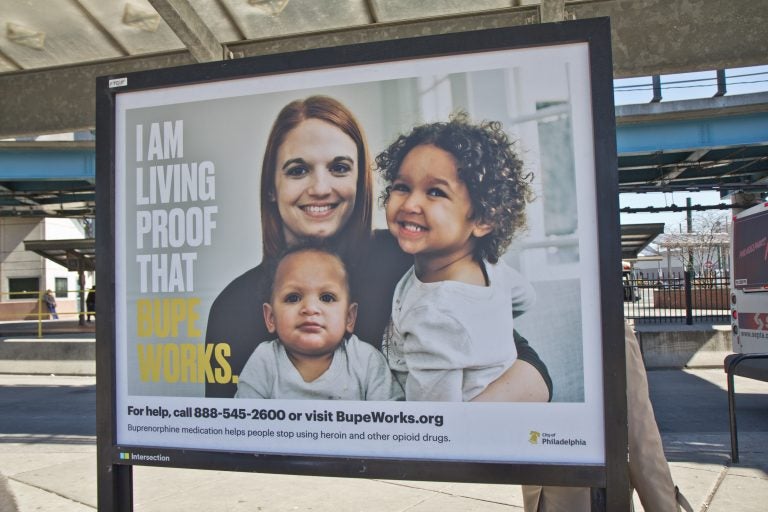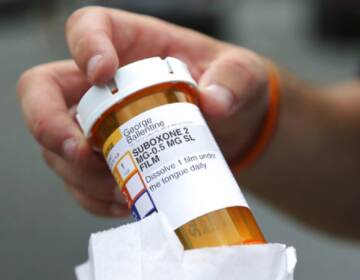Philadelphia promotes buprenorphine for opioid addiction treatment
A new citywide campaign features those who credit the treatment for their recovery. Health officials want people to know that buprenorphine is available and effective.

They city of Philadelphia has launched a media campaign to raise awareness about medicated assisted treatment for those addicted to opioids. (Kimberly Paynter/WHYY)
When Ronald McAdams got out of prison at age 60, he didn’t want to go back to Philadelphia.
He’d spent more than 30 years trying to kick his opioid addiction, in and out of rehabs and detoxes, and was afraid if he went back he’d get hooked again.
He was always wary of buprenorphine because he thought it was just another thing to become dependent on. But this time around, he gave it a try. That was a year ago, and so far, so good: McAdams is going to night school for his high school diploma.
“I always just wanted to do something, to be productive,” said McAdams, now 61. “But when that disease have you, it don’t care, it comes first. I was dry bones, I was walking dead around here. Never know what it was to feel freedom. But I have a sense of freedom now.”
McAdams’ face is one of many in the city’s new campaign to reduce the stigma around buprenorphine, a low-grade opioid considered the gold standard to treat opioid addictions. The $200,000 ad campaign will fund social-media posts, videos and billboards featuring the images and stories of real people who attribute their recovery to buprenorphine. The ads will appear in both Spanish and English, and the campaign is modeled after one that Philadelphia Health Commissioner Thomas Farley says was successful in New York.
City officials don’t have a good sense of how many people use heroin every day in Philadelphia. Their lowest estimate is 50,000, and it could be as many as double that. Farley said this campaign is designed for all people who use heroin, not just those who are homeless on the streets of Kensington.
“That’s not your typical people who are using heroin,” he said. “Most of the people who are injecting drugs are living at home, many are employed, so they are in many ways a hidden population.”
There about 12,000 slots for medication-assisted treatment in Philadelphia, a quarter of which are currently available. David T. Jones, commissioner of the Department of Behavioral Health and Intellectual disAbility Services, said that the number of people citywide receiving MAT has increased sixfold in the past three years.
He’s not worried about availability. Jones said the real push is to let people know it’s effective.
“If you’re ready for treatment, we have a slot for you,” he said.
Though this effort is geared toward promoting the treatment among prospective patients, the city is also working with doctors on the issue. Farley said his department has contracted with a technical assistance firm that’s helping physicians who may be uncomfortable prescribing buprenorphine to understand the real risks and benefits. The Health Department is also working with doctors, to walk them through the process of applying for “X” waivers, which allow physicians to prescribe the drug.
Buprenorphine works to stop cravings and ease the symptoms of withdrawal. It is taken orally, daily, and when combined with cognitive behavioral therapy, is considered the gold standard for opioid addiction treatment, along with methadone and Vivitrol, a long-lasting injectable.
Because buprenorphine is technically an opioid, it has the potential to be diverted or sold illegally. Some in the recovery community also consider it to be simply replacing one addiction with another.
Peter Kinzie was worried about judgment because of that. Like McAdams, Kinzie resisted buprenorphine because people said it didn’t count as being in recovery. But he would go to rehab time and time again, and always felt withdrawal symptoms even after a few months without using. Only when he finally tried buprenorphine did he feel like he could really function.
“I still don’t tell people what pretty much saved my life because I’m told that I’m not clean and not sober,” Kinzie said.
Now though, Kinzie’s face is on billboards all around town, so his attitude has changed.
“At the end of the day, if I’m not homeless, using drugs, stealing from my family, disappointing my girlfriend every day, and my family’s proud of me? That’s clean to me,” he said. “That’s sober to me.”
McAdams, who’s back in school and back on his feet, said the effects of buprenorphine made all the difference for him, too.
“I don’t have that obsession. I don’t have that compulsion that I used to have,” he said. “Them thoughts might come here and there, but I play the tape all the way through.”
McAdams hopes to become a certified peer specialist once he earns his diploma.
“I want to just be able to help somebody if it’s just one person,” McAdams said. “To let them know that they don’t have to wait til my age to get their life together.”
He expects to graduate this June. At age 61, he also plans to go to prom.
WHYY is your source for fact-based, in-depth journalism and information. As a nonprofit organization, we rely on financial support from readers like you. Please give today.




